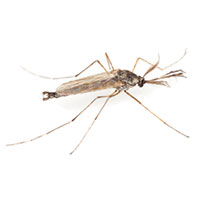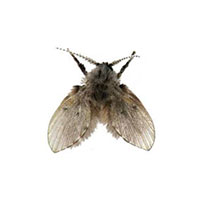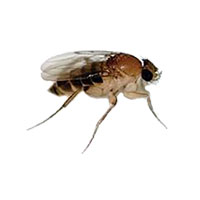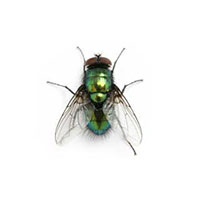Fruit Fly Diet
Fruit flies get their name because of their fondness for the moist surfaces of fruits. They prefer fruit that is fermenting, which occurs the moment you put it on a kitchen counter. Fruit flies are also like vegetables that are ripening in an open area. They will also gladly accept any leftover scraps of fruit or food that end up in sink drains, caught in filters, or in the garbage. The red-eyed fruit fly adults prefer fruits and vegetables that are in the earliest stage of decomposition. Dark-eyed fruit flies prefer their food in the later stages of decomposition. The larvae are found burrowed deep into moist, smelly organic debris.
Fruit flies search for foods such as:
- Liquids: beer, wine, cider, vinegar
- Fruits: bananas, grapes, peaches, pineapples, tomatoes, pickles, potatoes, onions
- Sugary substances: candy, soda
Fruit Fly Habitat
Fruit flies can become bothersome to homeowners and detrimental to businesses, especially in the food industry. They can be found in homes, restaurants, grocery stores, gardens, and anywhere else food is decaying or fermenting. Fruit flies make their way into places such as drains, trash containers, garbage disposals, empty beer, and soda cans, and wet mops.
Fruit flies can easily sneak into a house via groceries or any fruit or vegetable brought in from outside, even from your garden. Since the eggs and larvae are so small, they can easily be brought indoors unnoticed. Once they get inside, they grow into adults, lay more eggs, and become a problem.
Fruit Fly Life Cycle
Fruit flies are short-lived insects that breed rapidly. Like many insects, they go through several distinct phases during their life cycle. The length of the fruit fly life cycle is largely dependent on the temperature of the environment. At high temperatures, flies mature quickly and can complete their entire maturation in a week. For this reason, late summer is often the peak of fruit flies infestations, although the insects can be found indoors year-round.
Eggs
Female fruit flies deposit around 500 eggs on the skin of ripe or rotting fruits or vegetables or in poorly sealed containers housing these foods. The eggs hatch in about 30 hours.
Larvae
After hatching, the small, cream-colored larvae (maggots) emerge and immediately begin feeding on yeast from rotting produce. They are hardly visible to the naked eye.
Pupa
The maggots pupate after five days.
Adults
After the pupal stage, they emerge as winged adult fruit flies. Adult flies typically achieve sexual maturity within 48 hours and live for 40 or 50 days.
Signs of a Fruit Fly Infestation
The best way to spot a fruit fly infestation is by seeing the insects themselves. If you see an adult fruit fly, that typically means its larvae are close by. Fruit flies are most active during the spring and summer but can be active indoors year-round given the proper conditions. The presence of quickly decomposing produce attracts the pests and sustains their larvae. Check for any visible indications of fruit flies in drains, garbage disposals, trash cans, and food storage areas.
Fruit Fly Damage
Destroy Food
Fruit flies cause irreparable damage to fruits and vegetables.
Business Reputation
When left unchecked in bars, restaurants, grocery stores, and similar businesses, the presence of pests may lead to the loss of products and profits.
Disease
Though sometimes regarded as just a nuisance pest, the fruit fly can also carry certain disease-causing organisms from contact with excrement, trash receptacles, and dumpsters.
Sickness
In rare cases, humans and pets may ingest live larvae which can lead to myiasis and diarrhea.
Rapid Breeding
One reason fruit flies are considered such a nuisance is their ability to breed rapidly. They reach sexual maturity in a matter of days and are capable of laying hundreds of eggs in places like the skin of overripe fruit, dirty garbage disposals, piles of damp rags, and garbage cans. A single pair of breeding fruit flies can quickly turn into a major infestation that proves difficult to eradicate without professional help.
Fruit Fly Prevention
- Remove breeding sites by refrigerating fruits and vegetables. For reproduction, flies need a climate of at least 60 degrees Fahrenheit.
- Cover containers so flies are unable to land on food and feed and breed.
- Maintain proper sanitation of food preparation and storage areas to keep fruit flies away. Wipe down countertops or other food areas after use. Immediately clean up spills and debris, especially juices, sodas, and any other food with sugar. Clean out sink or floor drains to remove pieces of food.
- Clean behind appliances in restaurants and bars. Cleaning hard-to-reach areas, such as behind refrigeration units and under stoves where food can collect will help eliminate attractive breeding sites.
- Regularly empty trash cans and recycling bins so fruit flies don’t have a chance to establish. Wash inside and outside of trash containers.
- Wash fruits and vegetables prior to consuming or cooking them to remove any presence of eggs or larvae.
Fruit Fly Control
Fruit Fly Home Remedies
- Trapping the insects in a jar filled with cider vinegar or liquid soap, with a paper funnel serving as the lid.
- Chemicals and store-bought traps may also prove beneficial for smaller infestations. However, because the fruit fly is quick to reproduce, infestations can rapidly become uncontrollable.
Professional Fruit Fly Control
- Insect Light Traps: Many flies are attracted to certain wavelengths of UV light. This makes insect light traps very effective in attracting and capturing flies once they enter a building.
- Liquid Residual Insecticides: There are insecticides that work great at eliminating adult flies and larvae. Various liquid pesticides are ideal for only adult flies.
- Fly Baits: These baits use sugars and fly pheromones to lure flies into the trap.
Need help with Fruit Flies?
We'll call you! Leave your information below.
Pests Belong Outside!
Leave your information below and we will give you a call back.
"*" indicates required fields
*During normal business hours. After hours inquiries will be returned the next business day.






